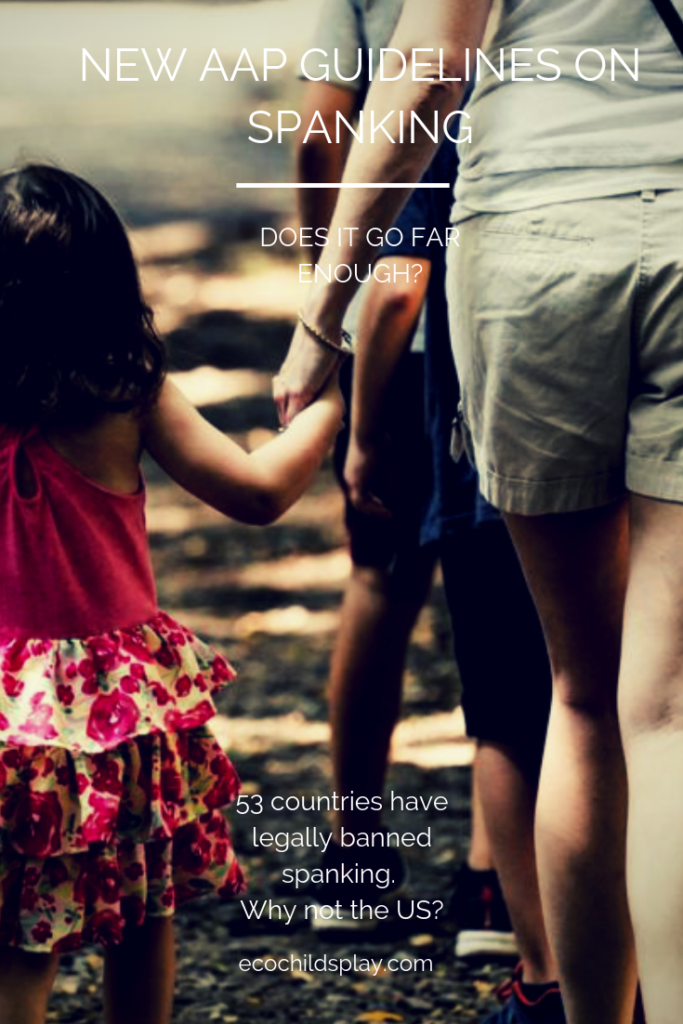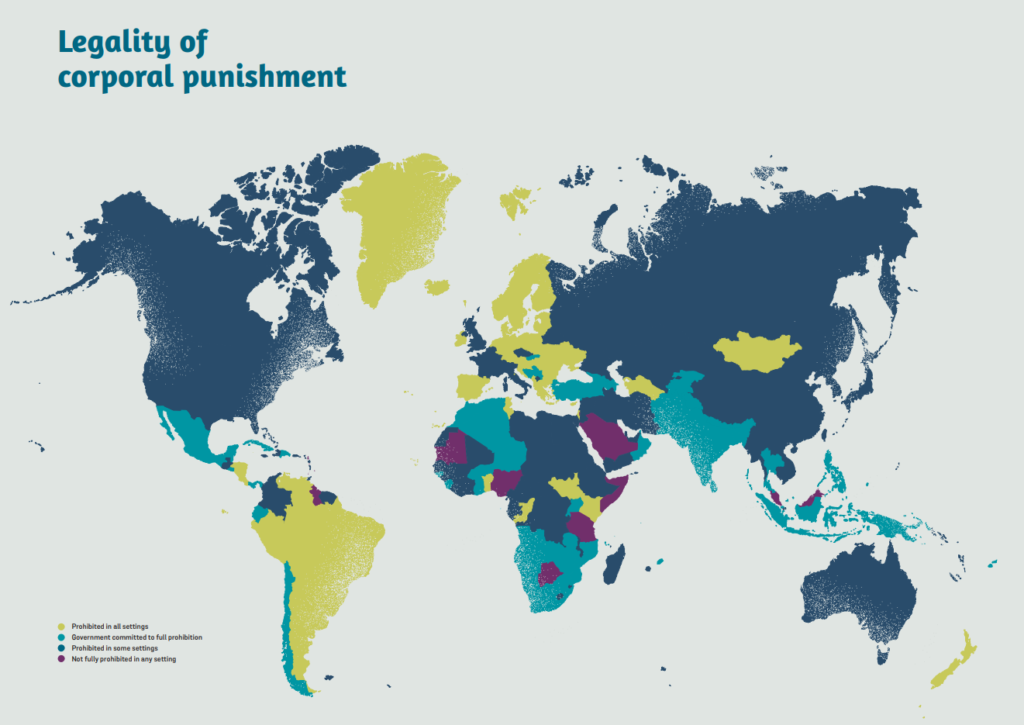
Spanking is defined as a form of corporal punishment that used to be standard in parenting in the US. It is legal in all 50 states as long as it is used as a form of discipline and does not leave a mark. A new American Academy of Pediatrics (AAP) policy (11/18) takes a stronger stance on this form of discipline.
The practice of spanking has been held up in court. Take for example the Massachusetts Supreme Judicial Court ruling that stated hitting your child is not criminal if it is “reasonably related to the purpose of safeguarding or promoting the welfare of the minor”. [note]https://www.bostonglobe.com/metro/2015/06/25/mass-high-court-outlines-legal-rules-spanking/AA75Y9oVRkEBGWIXCoY2fO/story.html [/note]
Spanking is so ingrained in America, the Massachusetts Supreme Judicial Court wrote the practice of hitting our children to get them to behave “remains firmly woven into our nation’s social fabric.” [note]https://www.parentmap.com/article/legal-united-states-spanking-kids[/note] It’s even allowed to be used by teachers in some states like Alabama. In fact, 19 states allow teachers to hit their students. [note]https://www.ncbi.nlm.nih.gov/pmc/articles/PMC5766273/[/note]

The rest of the world does not agree. 60 countries, territories, and states have banned or limited the practice. From Greenland to Cape Verde, hitting as a form of discipline is prohibited. [note]https://www.cnn.com/2018/03/12/health/spanking-laws-parenting-without-borders-intl/index.html[/note] 53 states of government have completely banned the practice. [note]http://endcorporalpunishment.org/wp-content/uploads/global/Global-report-2017-singles.pdf[/note] Sweden was the first to do so in 1979. [note]https://apolitical.co/solution_article/mapped-where-is-hitting-children-legal/[/note]
Spanking Doesn’t Work
Research does not support the practice as an effective method of parenting. In fact, it has quite the opposite effect. Reviewing 50 years of research, the Journal of Family Psychology reported:
The more you spank your children, the more likely they are to defy you and to develop issues including anti-social behavior and cognitive difficulties.[note]https://www.parentmap.com/article/legal-united-states-spanking-kids[/note]
Apolitical writes:
The biggest study to date, published in 2016, reviewed 75 studies published over 50 years involving over 160,000 children. Its conclusions were damning. It found links between corporal punishment and worse educational outcomes, higher levels of aggression, impaired brain development and a range of mental health issues, including anxiety and depression. Even witnessing violence as a child makes you more likely to enter into violent relationships in later life, either as the perpetrator, if male, or the victim, if female.
AAP Guidelines on Spanking
20 years ago, the AAP encouraged parents not to spank their children. In “Guidance for Effective Discipline”, the organization advised:
Corporal punishment is of limited effectiveness and has potentially deleterious side effects. The American Academy of Pediatrics recommends that parents be encouraged and assisted in the development of methods other than spanking for managing undesired behavior.[note]http://pediatrics.aappublications.org/content/101/4/723.long[/note]
Now, stronger language is used in the updated policy called “Effective Discipline to Raise Healthy Children”.
Aversive disciplinary strategies, including all forms of corporal punishment and yelling at or shaming children, are minimally effective in the short-term and not effective in the long-term. With new evidence, researchers link corporal punishment to an increased risk of negative behavioral, cognitive, psychosocial, and emotional outcomes for children. In this Policy Statement, the American Academy of Pediatrics provides guidance for pediatricians and other child health care providers on educating parents about positive and effective parenting strategies of discipline for children at each stage of development as well as references to educational materials. This statement supports the need for adults to avoid physical punishment and verbal abuse of children.[note]http://pediatrics.aappublications.org/content/early/2018/11/01/peds.2018-3112[/note]
Pediatricians are advised to discuss physical forms of discipline with parents, yet it does not call for legal changes as has been called for by the UN for almost 30 years.
In 1989, the United Nations (UN) Convention on the Rights of the Child, through its Committee on the Rights of the Child, called on all member states to ban corporal punishment of children and institute educational programs on positive discipline.5 In the UN report, article 19 reads, “Parties shall take all appropriate legislative, administrative, social, and educational measures to protect the child from all forms of physical or mental violence, injury or abuse, neglect or negligent treatment, maltreatment or exploitation, including sexual abuse, while in the care of [the] parent(s) [or] legal guardian(s) or any other person who has the care of the child.”[note]http://pediatrics.aappublications.org/content/early/2018/11/01/peds.2018-3112[/note]
We teach young children not to hit their friends. “These hands are not for hitting.” Yet, when they misbehave, the standard practice has been to hit them. Thankfully, the use of spanking has declined in the US. Younger parents look towards other discipline methods like timeouts, natural consequences, and redirection.
Instead of placing the burden on doctors to inform parents on the negative consequences of physical punishment, the AAP should be calling for an outright ban on the practice.
Studies have found that lower-income families rely more heavily on physical forms of punishments. According to Slate:
Spanking, by contrast, is an equal-opportunity punishment; it works equally well whether you’re rich or poor. So simple economics suggests that the very poor, with fewer alternatives available, should spank their kids more—and they do. Professor Bruce Weinberg of Ohio State University has studied this. He found that if you’re a kid in a $6,000-a-year household, you probably get spanked every six weeks or so. If your parents’ annual income goes up to $17,000, you’ll get spanked about once every four months. As income rises above about $17,000, spanking falls off more slowly; $40,000 and $120,000 households are not much different from $17,000 households.[note]https://slate.com/culture/2002/12/an-economic-explanation-for-spanking.html[/note]
Although children’s access to health care has improved, there is a direct link between income/health insurance and office visits. [note]http://pediatrics.aappublications.org/content/pediatrics/early/2016/11/11/peds.2016-2176.full.pdf[/note]
According to Child Trends, “In 2013, 68 percent of children younger than six who were not covered by health insurance had received a well-child check-up in the past year, compared with 92 percent of children who were covered by health insurance.” [note]https://www.childtrends.org/indicators/well-child-visits[/note]
Relying on pediatricians to deliver the message to families that spanking is harmful will not reach as many of the very parents that rely on physical punishment as a form of discipline. Those families visit the doctor less often.
Likewise, parental education is linked to the frequency of doctor visits, spanking, and seeking out parenting resources such as classes.


I applaud the AAP includes verbal abuse in its new policy, as well as research demonstrating its harm. For some parents, when they remove spanking from their discipline repertoire, it is replaced with harsh yelling.
Simply recommending parents do not use physical punishment is not a strong enough action by the AAP. They should follow suit of the UN and 53 other nations calling for a ban on spanking. It is not a matter of respecting parenting techniques, but the end of physical harm to children during critical development. It is the only way to get the message to all families that physical punishment is wrong.
All children need legal protection from physical punishment like spanking. It should not depend upon physcians and all the factors that contribute to whether or not families visit their offices to learn about the research.
Interesting statistics. What is glaringly absent in the report is the influence of religion on parents’ decision to use spanking as a form of punishment. In the churches I attended for many years, spanking was put forth as being biblical, effective and mandatory for parents to implement. To fail to spank (using “the rod of discipline”) meant that you didn’t really love your child. There are many, many Christians – and probably adherents of other religions – who believe this even today, and it’s not just the uneducated who do. Most everyone I knew in my former religious circle who spanked their kids were college graduates. It’s twisted, sick, and it grieves me to think I went along with it, too. Thankfully I came to my senses and realized how wrong it was. I have apologized to my children and they have graciously forgiven me.
Good points. I avoided the topic of religion in the post. I was spanked as a child for that very same reason I believe.
Thank you for this post! It is a topic that definitely needs more attention. I was honestly surprised to see the rates of spanking so low (as I imagined that most families do still spank), but I agree that it is usually replaced by yelling and/or shaming which is still unfortunate. People talking about it and being brave enough to mention it to family members and friends might be a good start to initiating change within local communities.